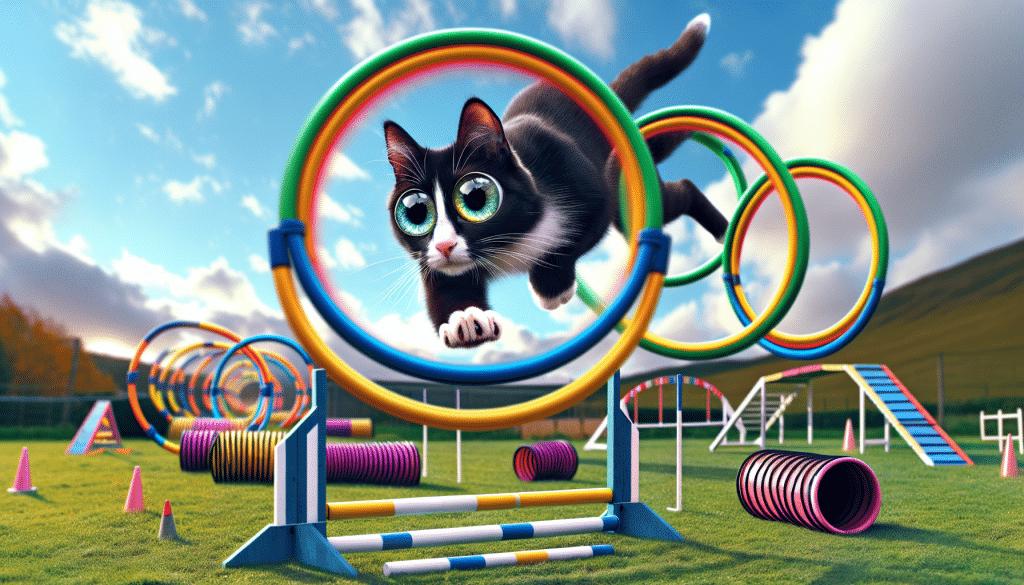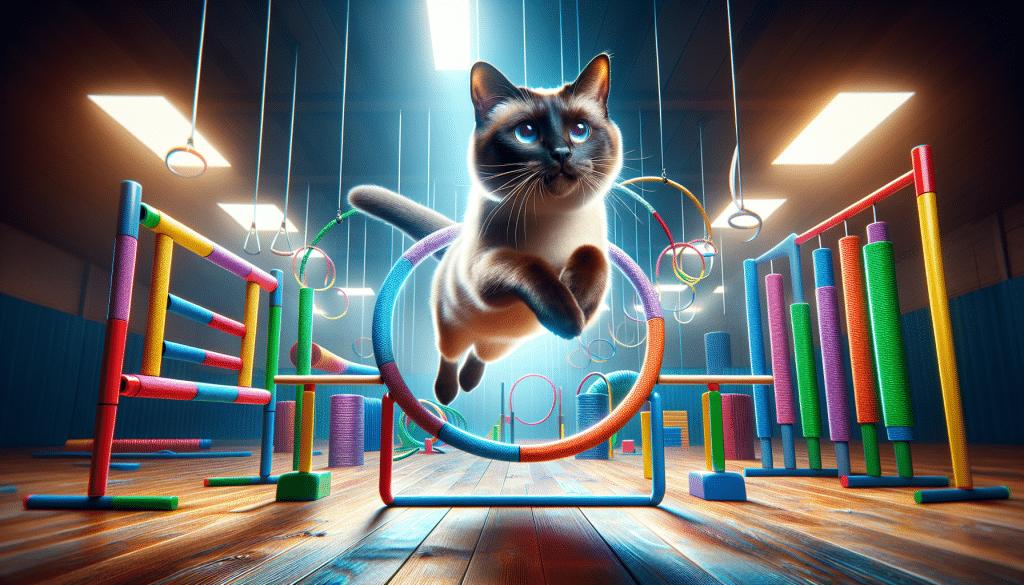In this article, you will learn how to train your cat for agility competitions. Agility competitions are like fun games where cats run through obstacle courses to show off their skills. You will discover simple tips and tricks to help your cat become faster, more flexible, and nimble. With patience and practice, you and your furry friend can have a great time mastering the art of agility training. So let’s get started and turn your little feline friend into an agile champion!

Understanding Cat Agility Competitions
Cat agility competitions are exciting events where cats and their owners showcase their agility skills. These competitions have gained popularity in recent years, and they provide a fun and interactive way for cats to stay active and mentally stimulated. Let’s explore the origin of feline agility contests, the rules and objectives involved, the different categories and obstacles, as well as the benefits of agility training for cats.
The origin of feline agility contests
Feline agility competitions originated from the popular dog agility competitions. Cat owners saw the potential in training their feline friends and allowing them to showcase their natural agility and athleticism. The first recorded cat agility competition took place in the early 2000s, and since then, it has grown into a competitive sport with enthusiasts from all over the world.
Rules and objectives in cat agility
In cat agility competitions, the main objective is for the cat to complete a predetermined course of obstacles, such as jumps, tunnels, weave poles, and platforms, within a given time limit. The cat and owner must work together to navigate through the course, with the owner providing verbal cues or hand signals to guide the cat. The rules may vary slightly between competitions, but they generally prioritize safety and fair play.
Categories and typical obstacles
Cat agility competitions are usually divided into different categories based on factors such as age, breed, and skill level. Some common categories include kittens, adult cats, and senior cats. Within each category, cats compete against others of similar age and skill level. Typical obstacles in cat agility courses include hurdles, tunnels, balance beams, weave poles, and various interactive obstacles. These obstacles are designed to test a cat’s speed, agility, and problem-solving abilities.
The benefits of agility training for cats
Agility training not only provides physical exercise for cats but also offers numerous mental and behavioral benefits. Cats performing agility exercises can improve their coordination, balance, and flexibility. It also helps reduce the risk of obesity and other health issues associated with a sedentary lifestyle. Additionally, agility training can help build confidence, reduce anxiety, and form a stronger bond between cats and their owners.
Assessing Your Cat’s Potential
Before embarking on agility training, it is important to assess your cat’s potential and suitability for this activity. Consider the following factors to determine if your cat is a good candidate for agility training.
Identifying signs of agility aptitude
Observe your cat’s behavior and natural instincts. Cats with a playful and curious nature are often more inclined to enjoy agility training. Look for signs of agility aptitude, such as climbing, jumping, and exploring new environments. If your cat exhibits these traits, they may be well-suited for agility training.
Considering your cat’s age and health for training
Age and health are crucial considerations when determining whether a cat is ready for agility training. Kittens may have limited coordination and may not be physically developed enough for certain obstacles. Senior cats, on the other hand, may have mobility issues that prevent them from participating safely. It’s important to consult with your veterinarian to ensure your cat is in good health and capable of handling the physical demands of agility training.
Understanding your cat’s motivation
Assess your cat’s motivation and willingness to participate in training sessions. Some cats may naturally be more food-motivated, while others may respond better to play or affection rewards. Understanding your cat’s motivation will help you tailor your training approach and keep your cat engaged and excited during the training process.
Building a bond with your cat
Building a strong bond with your cat is essential for successful agility training. Spend quality time with your cat, engage in interactive play sessions, and establish trust. This will make your cat feel more comfortable with you as their trainer and increase their confidence when facing new challenges.

Creating a Conducive Training Environment
To facilitate effective agility training sessions, it’s important to create a conducive training environment for your cat. Here are some factors to consider:
Choosing the right location for training
Select a quiet and spacious area in your home or backyard for training. This will provide ample space for your cat to move around and practice agility exercises without distractions. Ideally, the area should be free from hazardous objects and have a non-slip surface to ensure your cat’s safety.
Removing distractions during training sessions
Minimize distractions during training sessions by removing any toys, objects, or other animals from the training area. This will help your cat stay focused and prevent them from getting sidetracked. Creating a calm and controlled environment will make it easier for your cat to concentrate on the agility tasks at hand.
Ensuring safety and comfort for your cat
The safety and comfort of your cat should always be a priority. Ensure that the training area is free from potential hazards, such as sharp edges or loose wires. Provide soft bedding or mats for your cat to rest between training sessions. Additionally, keep the temperature in the training area at a comfortable level, as extreme temperatures can adversely affect your cat’s performance and well-being.
Scheduling regular training times
Consistency is key when it comes to agility training. Establish a regular training schedule that works for both you and your cat. Short, frequent training sessions are often more effective than longer sessions. Aim for several sessions per week, and gradually increase the duration and difficulty level of the exercises as your cat progresses.
Essential Equipment and Tools
Having the right equipment and tools is crucial for successful agility training sessions. Here are some essentials to consider:
Basic agility equipment for beginners
For beginners, a few basic agility equipment pieces are usually sufficient. Start with adjustable hurdles, collapsible tunnels, and weave poles. These versatile pieces will allow your cat to practice jumps, crawling, and weaving skills. Invest in equipment that is safe, sturdy, and specifically designed for cats.
DIY agility equipment options
If you’re on a budget or prefer a more hands-on approach, you can create agility equipment yourself using everyday items. For example, you can use PVC pipes and connectors to build hurdles or weave poles. Cardboard boxes can be transformed into tunnels or platforms. Just ensure that DIY equipment is safe and doesn’t pose any risks to your cat.
Using treats and toys as training tools
Treats and toys can be valuable training tools when teaching cats agility skills. Use small, soft treats that are easy for your cat to eat quickly. Reward your cat with a treat and praise whenever they successfully complete an agility task. Toys like feather wands or interactive balls can also be used as motivation and rewards during training sessions.
Investing in professional agility kits
For those who are serious about cat agility training and want to take it to the next level, investing in professional agility kits may be worthwhile. These kits often include a variety of obstacles, such as tunnels, hoops, and platforms. They are designed specifically for cats and provide a comprehensive training experience.

Getting Started with Basic Commands
Before introducing your cat to agility obstacles, it’s important to establish a foundation of basic commands. These commands will help you communicate with your cat during training sessions and ensure they understand what is expected of them. Here are some key points to consider:
The importance of clicker training
Clicker training is a popular and effective method of teaching cats. Using a clicker, a small handheld device that emits a distinct clicking sound, you can mark and reinforce desired behaviors. Pair each click with a treat or reward to associate the sound with positive reinforcement. Clicker training helps cats understand which actions are correct and helps them learn new commands more quickly.
Teaching ‘sit’, ‘stay’, and ‘come’ commands
Start with teaching your cat basic commands such as “sit,” “stay,” and “come.” Use verbal cues, hand signals, and the clicker to reinforce these commands. For example, when teaching “sit,” hold a treat above your cat’s head and slowly move it towards their tail. As their head goes up, their bottom will naturally go down into a sitting position. Click and reward when they successfully sit.
Using hand signals and verbal cues effectively
Hand signals and verbal cues can enhance communication with your cat during agility training. Use consistent gestures, such as pointing or hand raising, and pair them with specific commands. For example, use a raised hand signal and say “jump” when teaching your cat to navigate hurdles. Over time, your cat will associate the hand signal and verbal cue with the corresponding action.
Progressing from simple to complex commands
Once your cat has mastered the basic commands, you can gradually introduce more complex commands. For example, you can teach them to crawl through tunnels, weave through poles, or jump over higher hurdles. It’s important to progress at a pace that your cat is comfortable with and always reward their progress and effort.
Introducing Your Cat to Agility Obstacles
When it’s time to introduce your cat to agility obstacles, take a gradual and patient approach. Here are some tips to help you introduce your cat to different types of obstacles:
Familiarization with different types of obstacles
Allow your cat to explore and get familiar with each obstacle before attempting any training exercises. Let them inspect the equipment, sniff the tunnels, and investigate the poles. This will help ease any anxiety or hesitation they may have initially.
Breaking down training into manageable steps
Break down each obstacle into smaller, manageable steps that your cat can easily understand and accomplish. For example, when introducing jumps, start with very low heights and gradually increase over time. This incremental approach builds your cat’s confidence and ensures they have a solid foundation before progressing to more challenging tasks.
Positive reinforcement techniques
Positive reinforcement is crucial during agility training. Whenever your cat successfully completes an obstacle or follows a command, reward them with praise, treats, or playtime. This positive experience will motivate your cat to continue learning and performing well.
Coping with your cat’s frustrations and setbacks
Just like humans, cats can sometimes get frustrated or experience setbacks during training. If your cat becomes overwhelmed or disinterested, take a break and come back to training later. Keeping training sessions enjoyable and stress-free will help your cat stay motivated and engaged. Always be patient and understanding with your cat throughout the training process.
Agility Drills and Skill Development
Once your cat is comfortable with the basic obstacles, it’s time to focus on agility drills to develop their skills further. Here are some drills to help improve your cat’s coordination, balance, speed, and mental agility:
Creating a variety of agility drills
Mix up the obstacles and create various combinations for your cat to navigate. For example, set up a sequence that includes jumping over hurdles, weaving through poles, and crawling through a tunnel. Varying the drills will keep your cat engaged and mentally stimulated.
Building your cat’s coordination and balance
Include exercises that focus on coordination and balance. For example, set up a balance beam for your cat to walk across or place small platforms at different heights for them to jump onto. These exercises will refine your cat’s motor skills and help them navigate more challenging obstacles with ease.
Increasing speed and accuracy over time
As your cat becomes more proficient, focus on increasing their speed and accuracy. Set up timed drills where your cat completes obstacles within a specific timeframe. Use treats or toys as rewards for achieving goals quickly and accurately.
Developing mental agility and focus
Introduce exercises that require your cat to think and problem-solve. For example, use treat puzzles or hidden toy games to encourage mental agility. This will help your cat stay focused and make quick decisions when faced with unfamiliar situations during agility courses.
Advanced Training Techniques
Once your cat has mastered the basics and built a solid foundation of agility skills, you can introduce advanced training techniques to further improve their performance. Here are some techniques to consider:
Introducing time trials and competitive elements
Simulate a competitive environment by introducing timed drills and challenging your cat to complete the course as quickly as possible. Use a stopwatch to measure their progress and encourage healthy competition. Remember to always prioritize your cat’s safety and well-being, and never push them beyond their limits.
Combining obstacles for complex runs
Combine different obstacles to create more complex runs. For example, design a course that incorporates jumps, tunnels, and weave poles in various configurations. This will test your cat’s ability to navigate through different obstacles in a seamless and efficient manner.
Refining techniques and building muscle memory
Continuously work on refining your cat’s techniques. Pay attention to their form, speed, and precision. Regular practice will help build muscle memory, allowing your cat to perform agility moves more effortlessly. Focus on establishing good habits to ensure consistency and accuracy in their performance.
Adapting training to your cat’s learning style
Each cat has a unique learning style and preferences. Pay close attention to what motivates and engages your cat the most. Adapt your training methods accordingly to ensure your cat enjoys the process and remains motivated to learn and improve.
Preparing for a Competition
If you and your cat are ready to take your agility skills to the next level and participate in a competition, here are some essential preparations to consider:
Understanding competition protocols
Familiarize yourself with the specific rules and regulations of the competition you plan to participate in. This includes understanding the course layout, time limits, scoring criteria, and any additional requirements or restrictions.
Simulating a competition environment at home
Create a mock competition environment in your training area to help your cat adjust to the atmosphere and distractions they may encounter during an actual competition. Practice in an area with increased noise, introduce new objects, or invite friends over to act as spectators. This will help your cat become more comfortable and focused in a competitive setting.
Dealing with distractions and stress in a competitive setting
Competition settings can be stressful for both cats and owners. It’s important to remain calm and focused to help alleviate any stress your cat may experience. Incorporate relaxation techniques, such as deep breathing and positive visualization, to help you and your cat stay calm and connected.
Strategies for keeping your cat calm on competition day
On the day of the competition, stick to your routine and ensure your cat gets proper rest, food, and exercise. Keep your cat’s stress levels low by providing a familiar and comfortable environment. Bring their favorite toys or bedding to help them feel more secure and relaxed. Remember to reward your cat for their effort, regardless of the competition outcome, to maintain a positive experience.
Joining the Cat Agility Community
Participating in cat agility competitions opens up a world of opportunities to connect with other cat agility enthusiasts. Here are some ways to get involved in the cat agility community:
Finding local agility clubs and groups
Search for local agility clubs or groups in your area. These clubs often host training sessions, workshops, and competitions. Joining a club will allow you and your cat to connect with fellow enthusiasts, share experiences, and receive guidance from experienced trainers.
Networking with other cat agility enthusiasts
Attend agility competitions and events to meet other cat owners and enthusiasts. Network with fellow competitors, exchange training tips, and grow your knowledge about the sport. Building a support network of like-minded individuals will enhance your agility journey and provide opportunities for growth.
Learning from experienced trainers and competitors
Take advantage of the knowledge and experience of seasoned trainers and competitors. Attend training seminars or workshops conducted by experts in the field. Learn from their expertise and apply their techniques to improve your own training approach.
Sharing experiences and tips on social media and forums
Social media platforms and online forums dedicated to cat agility are excellent platforms to connect with the cat agility community on a larger scale. Share your experiences, seek advice, and contribute to the discussions. This virtual community can provide invaluable support and inspiration throughout your cat agility journey.
In conclusion, cat agility competitions offer a unique and engaging way for cats to stay physically active and mentally stimulated. With proper assessment, training, and a supportive environment, any cat can participate and excel in agility activities. Remember to always prioritize your cat’s well-being, enjoy the process, and celebrate the bond you and your feline friend will build on this exciting journey.



